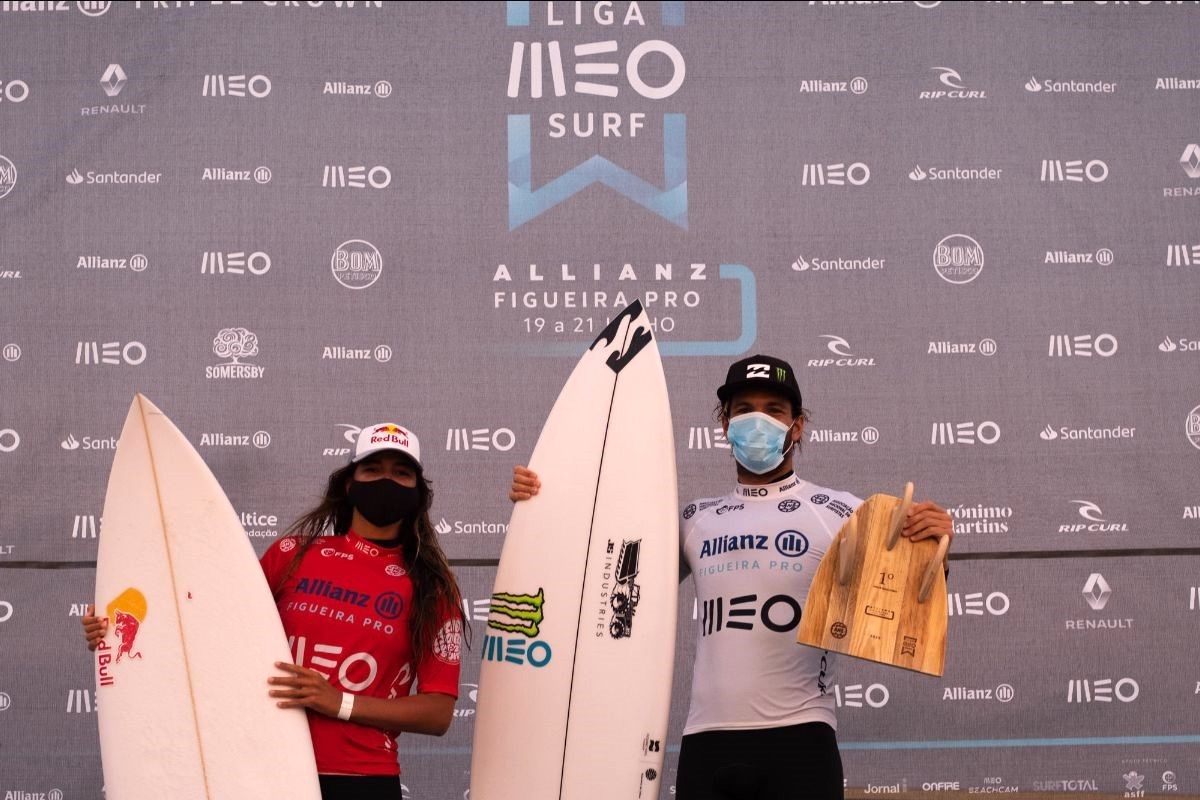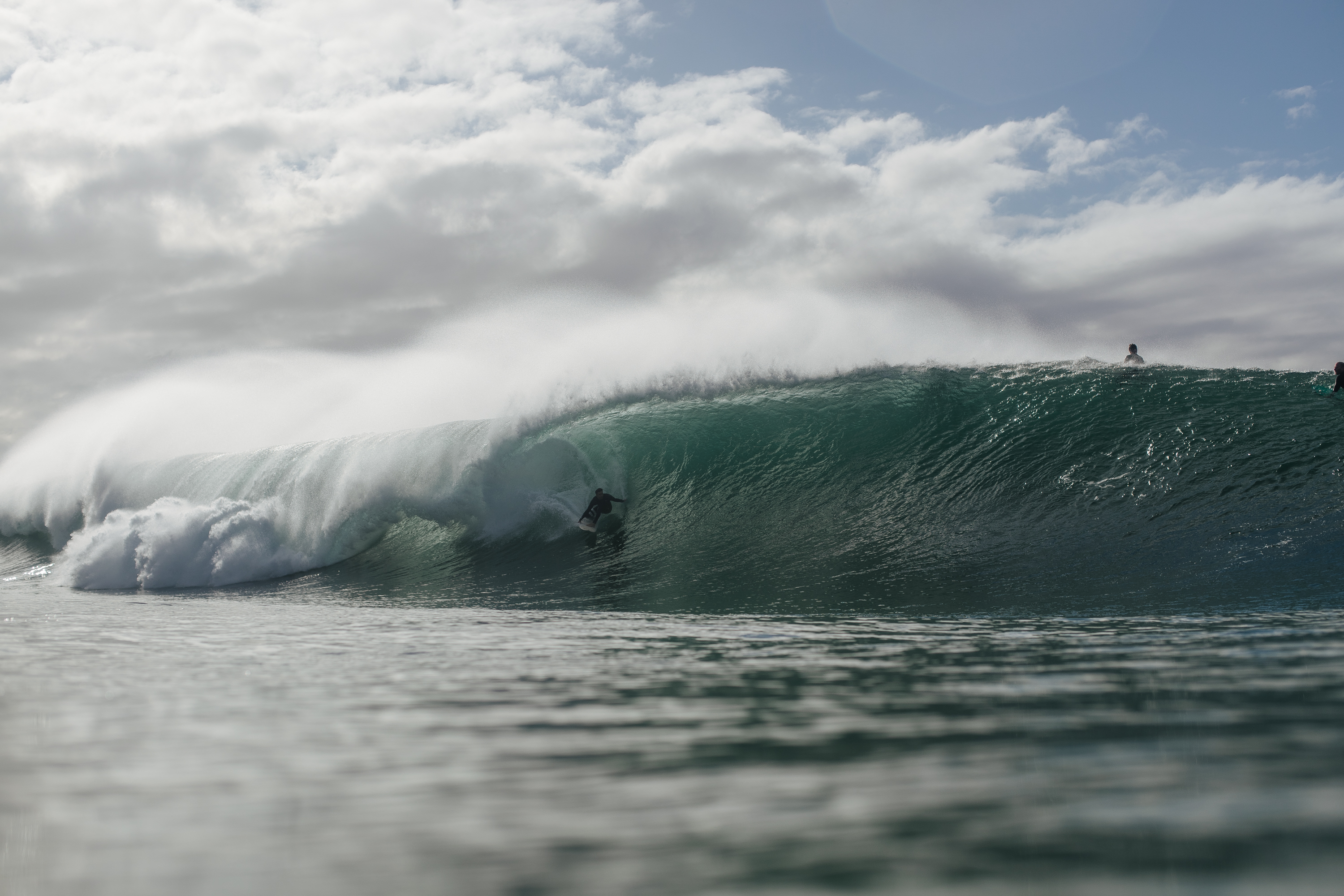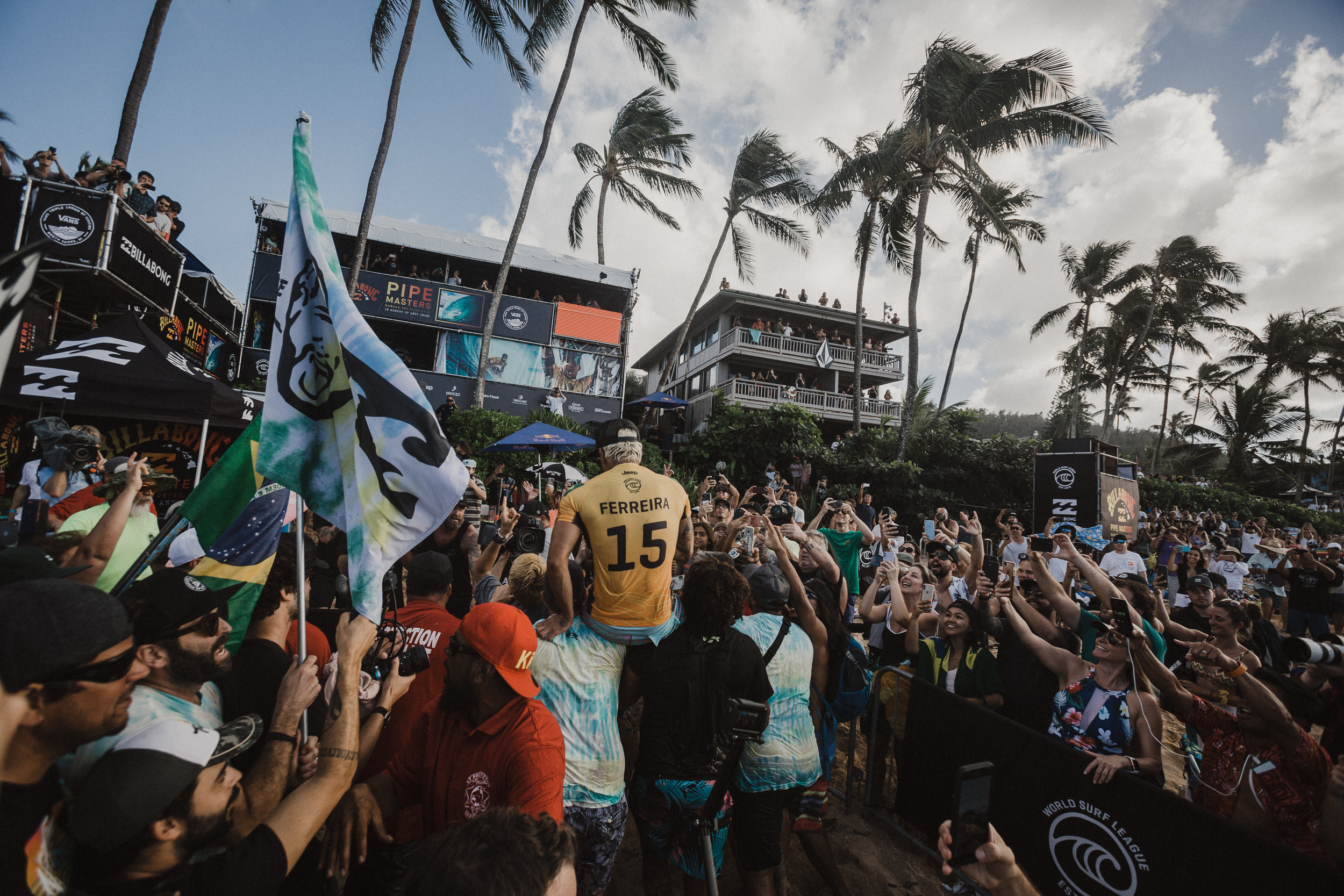A couple weeks ago — in Portugal of all places — an extraordinary thing happened. They held a surf contest.
The contest was called the Allianz Figueira Pro and it was leg number one of Portugal’s five event national championships, a thing they call the MEO Surf League. (Won in da Foz’s fun beachies by Teresa Bonvalot and Frederico Morais, just so ya know.)

“Winning after confinement, before confinement or at any other time is always incredible,” Morais wrote. “This time it was a different podium…I had to add the mask but it was a special one! First post COVID-19 surf championship is done! Lucky to have an awesome Portuguese league.” Photo: Matreno_Photo
You’d never have heard about this event except for the fact that as far as I can tell, it was the first live surfing competition since the Aussie boardriders’ March club pointscore rounds. And it was followed by another regional event in Hossegor, France on July 7th — which was won by Johanne Defay and Kuali Vaast (who nailed a perfect 20 heat total in the final).
For three months, surf culture — that is you, me, and every surfer we know — has been in the midst of a completely inadvertent experiment.
Thanks to the COVID, organized surfing everywhere has been flat on its back. Competition has ceased to exist. Surfing events generally have ceased to exist. Not just a little bit, but totally. This has never happened before in the modern history of the sport.
Yet at the same time, actual surfing, the plain old activity, has blown up almost as never before.
Right now we’re almost three months into the biggest sustained boom in surfing numbers since around 1991 — date of the last truly global recession.
The boom is not confined to any one little patch of the world. It doesn’t seem to matter whether or not surfing was put on hold by the virus or not. If it was, like in parts of the US and Europe, then when beaches were re-opened, people charged in like baby turtles in hatching season.

Across Australia and the US, surfing has been more popular than ever during COVID — thanks to pumping swell, government stimulus checks, and loads of free time. Here’s Sydney, June 27th. Photo: Matt Dunbar
If it wasn’t, like where I live in Australia, people just kept piling in. Surfboard makers like JS who, fearing the worst, had initially closed up shop, were forced to re-open, then to take on new staff to meet crazy floods of off-season orders. The crew at my local surfboard specialists, Onboard, were stunned. “We stopped production,” one of them told me, “then everyone came in here with (the government’s stimulus) check.”
Wetsuit sales reached historic highs. Rip Curl, whose sales records go back to 1969, broke them all — the records, that is. Surf shops, if they’re open, are running out of wax. Try buying a set of fins online right now.
It reminds me of something somebody told me back in ’91 — a man knee-deep in core surf gear at the time. “We’re recession-proof!” he said.
Yet in this boom-a-rama, surf organizations have struggled to find a place. Smaller ones seem to have done better than big ones. Boardriding clubs in Western Australia were able to seriously influence the key debate over how to keep people surfing through the lockdown. Surfing NSW played a real role in the re-opening of Sydney’s famed Maroubra Beach to surfers, after it and the even more famed Bondi were closed in a sketchy response to too much sunbaking. Maroubra’s re-opening led directly to Bondi’s re-opening, and a return to sanity around the issue. No Aussie beach has since been closed to riding waves.
That was something. But in general, when it came to assisting surf communities through this very weird time, surfing bodies worldwide could only fall back on advice listicles, published on their websites — you know, don’t surf in crowds, social distance, all that. If you’ve been surfing anywhere in Australia or the US over the past coupla months, you will know what effect that had.
They just don’t count. All those people charging into the water over the past three months don’t even know they exist.
Further up the chain, it’s even heavier.
The International Surfing Association, cock-a-hoop six months ago with the first surfing Olympics hovering in the middle distance, has had to fall back on a rescue package from the International Olympic Committee, presumably part of the $400,000 the ISA was slated to receive from the IOC in the wake of Tokyo 2020. All the ISA’s events for this year have been cancelled, including their once critical pre-Olympic qualifier in El Salvador.
The World Surf League, man, it’s suspended in mid-air. They haven’t been exactly idle. For the past three months, the WSL braintrust has been hard at work trying to set in place a whole new world tour set-up.* The surfers are split on it. The events, they’d just like to run, whatever the set-up.
But right now, it seems almost academic. With the US in a dreadful state and international travel receding into the distance, professional sports that try to skim past the hard facts of the COVID end up humiliated. For an example, you don’t need to go further than world tennis number one Novak Djokovic, who promoted a pro tennis mini-tour in the Balkan states and invited international pros to join; he’s now got the ‘rona, along with his pregnant wife.
And surely it must be clear now to the WSL, after three months of replays, that if there’s no events, there’s no WSL.

Massive crowds, unhindered international travel to CT events, and not a face mask in sight. Looking back at the Before Times with Italo Ferreira’s 2019 championship win on the sand at Pipeline. Photo: Jeremiah Klein
Normalcy will resume, eventually. Local and regional surf competitions are already on the way back. Boardriders clubs around Australia will be allowed to run events from this coming weekend, likewise the French national body. In the US, the NSSA has events tentatively on the books for mid-July and early August at Huntington Beach, and Surfing America are hoping to run events on both coasts starting August — though all are awaiting city and state clearance. The Rip Curl GromSearch series has gone digital, leading up to an in-person event scheduled for October at the BSR wavepool in Waco, Texas.
But there won’t be world pro surfing champions in 2020. What if there can’t be in 2021?
Now if you’re not a fan of competition in surfing, this may be causing you some schadenfreude. I dunno if I would rush in on that score, because there’s another lesson here.
I can’t count the number of times I’ve read and heard from disgruntled surfers of a certain age that pro surfing’s greatest evil is its promotion of surfing — that it encourages people into the sport, causing crowds and all the rest of it, thus destroying all our dreams.
And surely it must be clear now to the WSL, after three months of replays, that if there’s no events, there’s no WSL.
Well I reckon the past few months is devastating proof to the contrary.
Maybe this is the biggest point of COVID as far as surfing’s concerned.
On the one hand, a massive numbers boom — on the other, an utter cessation of surfing competition. How do these two things match up? They can’t, unless you accept a fundamental fact about surfing’s true appeal, about what people hope for when they paddle out.
Competition has played a fascinating part in the evolution of surfing. Once, it was a way for the tiny tendrils of a barely formed surf culture to reach out and make contact; a meeting place of a kind. That’s why they used to call Bells a “rally”.
Then it became all sorts of other things. And it probably will again.
But it’s not why people surf.
*We’ll get around to this, don’t you worry.





Recent Comments